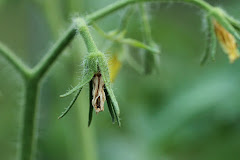 Transplants being produced for setting out in mid to late May should be well along by now. The peppers in the photo are being grown for sale at our Plant-A-Palooza fundraiser. They are the improved chile types described in the recent “Back to the Future” article about chile seed that was cleaned up to be the more productive and flavorful peppers they used to be. Information on the sale is in the top right corner of the blog.
Transplants being produced for setting out in mid to late May should be well along by now. The peppers in the photo are being grown for sale at our Plant-A-Palooza fundraiser. They are the improved chile types described in the recent “Back to the Future” article about chile seed that was cleaned up to be the more productive and flavorful peppers they used to be. Information on the sale is in the top right corner of the blog.It’s been hard with recent cold/warm weather punctuated by rain/snow to move transplants outdoors during the day for a dose of sunshine. Even when day temperatures have been above 55 degrees F for peppers and tomatoes, it’s often been excessively windy. While mild wind is fine for promoting strong stems, gales are not.
Shuttle homegrown transplants outdoors on warm, calm days and bring them in before temperatures cool too much in late afternoon. This acclimates plants to drier air and UV light, helps build thicker stems with flexing from wind movement, and provides higher light intensity than generally available indoors. Leave plants indoors when air temperatures are in the low 50’s or below. Of course transplants of cabbage and other cool season crops will withstand cooler temperatures. Many of these should have been set out and already out of the house.
 Do balance light and temperature to promote growth with adequate fertilization for good plant color. Avoid excessive fertilization which produces lanky, succulent growth. Watch for golden yellow lower leaves that indicates the need for nitrogen fertilizer and for purpling suggesting the need for phosphorous (photo left).
Do balance light and temperature to promote growth with adequate fertilization for good plant color. Avoid excessive fertilization which produces lanky, succulent growth. Watch for golden yellow lower leaves that indicates the need for nitrogen fertilizer and for purpling suggesting the need for phosphorous (photo left).Between timing seed planting to have the plant the right size to set out, manipulating the environmental light and temperature conditions, and regulating fertilizer nutrients, growing transplants is an art as well as a science.
Photo credit: Chile pepper transplants, Phosphorous deficient tomato - both Carl Wilson








